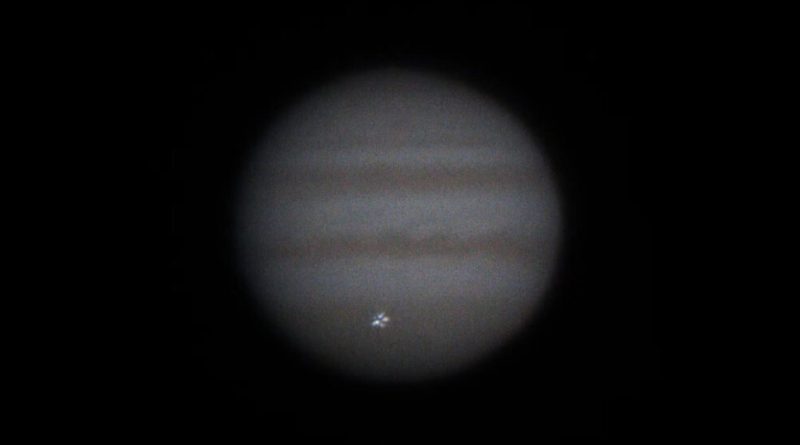A Fireball Whacked Into Jupiter, and Astronomers Got It on Video
[ad_1]
Ko Arimatsu, an astronomer at Kyoto University in Japan, received an intriguing email a couple of weeks ago: An amateur astronomer in his country had spotted a bright flash in Jupiter’s atmosphere.
Dr. Arimatsu, who runs an observation program to study the outer solar system using backyard astronomy equipment, put out a call for more information. Six more reports of the Aug. 28 flash — which, according to Dr. Arimatsu, is one of the brightest ever recorded on the giant gas planet — came in from Japanese skywatchers.
Flashes like these are caused by asteroids or comets from the edges of our solar system that impact Jupiter’s atmosphere. “Direct observation of these bodies is virtually impossible, even with advanced telescopes,” Dr. Arimatsu wrote in an email. But Jupiter’s gravity lures in these objects, which eventually slam into the planet, “making it a unique and invaluable tool for studying them directly,” he said.
Characterizing these flashes is a crucial way to understand our solar system’s history. They offer “a glimpse of the violent processes that were happening in the early days of our solar system,” said Leigh Fletcher, a planetary scientist at the University of Leicester in England. It’s like “seeing planetary evolution in action,” he added.
Today, powerful impacts into Jupiter are a lot more rare, but they do occur. In 1994, one comet whacked into Jupiter with so much force that it left a visible debris field. Astronomers saw another massive impact in 2009.
Most collisions with Jupiter, the solar system’s fifth planet, are witnessed opportunistically by amateur astronomers. (Eight of the nine flashes seen on Jupiter since 2010 were reported by amateurs, according to Dr. Arimatsu.) Typically they use a technique called lucky imaging, which takes a video of a portion of the sky at a high frame rate.
Those frames contain “a treasure trove of data,” Dr. Fletcher said, from which professional astronomers can deduce information about Jupiter’s atmosphere, meteorology and storms.
According to Dr. Arimatsu’s initial analyses, the flash reported in August had an impact comparable to the 1908 Tunguska explosion in Siberia, which experts believe was an asteroid that ripped apart 800 square miles of forest. This is the second Jupiter event observed in the past decade with this much energy, said Dr. Arimatsu, who reported the last one in 2021, with an estimated energy equivalent to two megatons of TNT.
Still, the latest impact wasn’t strong enough to leave behind a visible debris field, Dr. Fletcher said. Scientists study such traces to learn how the chemistry and temperature of Jupiter respond. Similar collisions might once have been important for generating the composition of planets seen in our own solar system, he added, and maybe in others, too.
Astronomers focus on Jupiter because it’s big, making it easy to see and more likely to suffer the impact of cosmic debris. But some scientists think that Saturn’s rings were once shaped by such explosions, and tentative evidence indicates that Uranus and Neptune have also been hit.
“If I was a betting man, I would say that all of our giant planets are being bombarded by asteroids and comets,” Dr. Fletcher said.
Stargazers are waiting for the next big flash — one that will create enough wreckage to be seen from Earth. When that happens, astronomers around the world will turn their telescopes toward Jupiter to study the fallout, with the James Webb and Hubble Space Telescopes likely to join in, too.
But because these winks in space are captured by chance, it’s the amateurs who are really pulling the weight in this line of research. “You can’t have hours and hours, night after night, on big professional telescopes,” Dr. Fletcher said. “You have to have dedicated backyard astronomers across the globe to be able to do it.”
Dr. Arimatsu also emphasizes the importance of small-scale astronomy initiatives in a field overrun by massive projects. “It’s a vital part of the scientific community that often goes overlooked,” he said.
